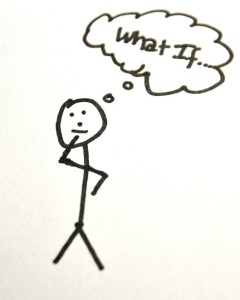 The term what if has been used by motivators and trainers to encourage people to challenge their beliefs and think of new ways of doing things.
The term what if has been used by motivators and trainers to encourage people to challenge their beliefs and think of new ways of doing things.
I have been using this lately to spark creativity and better collaboration and teamwork. You can do the same whether you’re a leader or a team member working on a project. This approach works best when working on a specific project but it can also work to spark ideas to improve an existing situation or process.
How it works
When working on a project with a deliverable by one of your team members there is always specific tasks or milestones to achieve towards realizing the finished product. When someone presents their work for review and approval we either approve it or tell the person what we think should be different. Rather than saying what you want them to change, you could use the what if approach to suggest the change. It may sound like the same thing but there’s a subtle difference, which can have a powerful impact on the way the other person perceives your feedback. By saying what if you are not insinuating that what they have done is wrong, but rather suggesting a modification or alternative.
Ideally you would combine positive feedback with the what if. You would say what you like about what they’ve done and then use the what if to suggest what could be improved or changed.
Example
Suppose someone is working on a PowerPoint presentation that you’ve requested. They send you a draft of the presentation and there are certain things that you like but several that you don’t. The first step is to tell them what you like about their work and then you use the what if to suggest the changes you want.
For example if you like the template that was chosen you would point that out and why. You could say “your choice of template was well thought out as it really represents the image we want to project for this presentation”.
But let’s say there’s too much text and not enough images on some of the slides. You could say “what if you use powerful images to represent the points and reduced the text to a few words to complement the images?” You could continue to add more what if’s to suggest more of your ideas. Once you start with one what if more seem to flow easily.
Visualization
 Somehow using what if generates images in the mind, not only for yourself but for the person receiving your ideas. This helps everyone get a better picture of what the outcome should look like.
Somehow using what if generates images in the mind, not only for yourself but for the person receiving your ideas. This helps everyone get a better picture of what the outcome should look like.
Motivational approach
This type of approach is more motivating for everyone as it stimulates creativity and collaboration. Rather than receiving negative feedback and then being told what to do, using what if feels more creative and collaborative. And if you suggest that your team members use this approach as well you could bounce what if ideas off each other and come up with some really crazy concepts that just might work and make your project excel and standout.
Get going using this now and see what if!
Stephen Goldberg